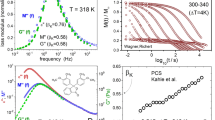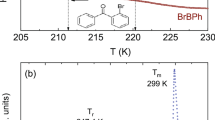Abstract
Several relaxation modes present in poly(propylene glycol) monobutyl ether [PPGMBE] were explored over a wide temperature range (120–310 K) and frequency band range (10 mHz–1.0 GHz) using wideband dielectric spectroscopy. Two resolvable secondary relaxations (β- and γ-processes) were observed below Tg, along with a structural relaxation mode (α-) above Tg. The β-relaxation process was well fitted with the Cole–Cole equation and was identified as true Johari Goldstein relaxation based on an aging experiment and a coupling model prediction. The spectra for the γ-process showed asymmetric behavior below Tg, hence it was well described by the Havriliak-Negami equation and did not show any of the peculiar behavior seen with many PPG families. The T-dependences of several dielectric properties, e.g., τα, τβ, τγ, τσ, and σdc, were thoroughly investigated. It was noticed that the T-variation of the relaxation time for the α-mode was not satisfactorily described with only one VFT equation, and the derivative plot indicated a crossover temperature of ~240 K. Our experimental findings demonstrated that a logarithmic plot of the σdc versus τα data showed nonlinear dependency and thus were expressed by the fractional Stokes-Einstein–Debye law, with a change in the exponent from ζ = −0.70 to −0.85 for high-T (>240 K) and low-T behavior (<240 K), respectively.

Broadband dielectric spectroscopy was employed to study the relaxation dynamics in poly(propylene glycol) monobutyl ether [PPGMBE]. Two relaxation processes (β- and γ-) were observed in the sub-Tg region, in addition to the α-process above Tg. The physical aging experiment performed below Tg suggested that the observed β-process is the genuine Johari Goldstein relaxation process and the γ-process is of intramolecular origin.
This is a preview of subscription content, access via your institution
Access options
Subscribe to this journal
Receive 12 print issues and online access
$259.00 per year
only $21.58 per issue
Buy this article
- Purchase on Springer Link
- Instant access to full article PDF
Prices may be subject to local taxes which are calculated during checkout










Similar content being viewed by others
References
Wang CH, Fytas G, Lilge D, Dorfmüller T. Laser light beating spectroscopic studies of dynamics in bulk polymers: poly(propylene glycol). Macromolecules. 1981;14:1363–70.
Eckert-Kastner S, Meier G, Alig I. Phase behaviour of mixtures of polyethylene glycol and polypropylene glycol: Influence of hydrogen bond clusters on the phase diagram. Phys Chem Chem Phys. 2002;4:3743–49.
Eckert-Kastner S, Meier G, Alig I. Phase behaviour of mixtures of polyethylene glycol and polypropylene glycol: Influence of hydrogen bond clusters on critical composition fluctuations. Phys Chem Chem Phys. 2003;5:3202–11.
Connor TM, Blears DJ, Allen G. Proton spin-lattice relaxation in polypropylene oxides. Trans Faraday Soc. 1965;61:1097–109.
Vogel M, Torbrugge T. Nonexponential polymer segmental motion in the presence and absence of ions: 2H NMR multitime correlation functions for polymer electrolytes poly(propylene glycol)-LiClO4. J Chem Phys. 2007;126:204902.
Barlow AJ, Erginsav J. Viscoelastic properties of poly(propylene glycols). Polymer. 1975;16:110–14.
Cochrane J, Harrison G, Lamb J, Phillips DW. Creep, creep recovery and dynamic mechanical measurements of a poly(propylene glycol) oligomer. Polymer. 1980;21:837–44.
Smith SW, Freeman BD, Hall CK. Pressure-dependent photon correlation spectroscopic investigation of poly(propylene oxide) near the glass transition. Macromolecules. 1997; 30: 2052–7.
Moon IK, Jeong YH, Furukawa T. Enthalpy and dielectric relaxation in the glass transition region of polypropylene glycol. Thermochim Acta. 2001;377:97–104.
Singh LP, Cerveny S, Alegría A, Colmenero J. Dynamics of water in supercooled aqueous solutions of Poly(propylene glycol) as studied by broadband dielectric spectroscopy and low-temperature FTIR-ATR spectroscopy. J Phys Chem B. 2011;115:13817–27.
Pawlus SS, Hensel-Bielowka S, Grzybowska K, Zioło J, Paluch M. Temperature behavior of secondary relaxation dynamics in tripropylene glycol. Phys Rev B. 2005;71:174107.
Kaminski K, Kipnusu WK, Adrjanowicz K, Mapesa EU, Iacob C, Jasiurkowska M et al. Comparative study on the molecular dynamics of a series of polypropylene glycols. Macromolecules. 2013;46:1973–80.
Grzybowska K, Grzybowski A, Zioło J, Paluch M, Capaccioli S. Dielectric secondary relaxations in polypropylene glycols. J Chem Phys. 2006;125:044904.
Engberg D, Schüller J, Strube B, Sokolov AP, Torell LM. Brillouin scattering and dielectric relaxation in PPG of different chain lengths and end groups. Polymer. 1999;40:4755–61.
Beevers MS, Elliott DA, Williams G. Molecular motion in melt samples of poly (propylene glycol) studied using dielectric and Kerr effect relaxation techniques. Polymer. 1980;21:13–20.
Mattsson J, Bergman R, Jacobsson P, Borjesson L. Chain-length-dependent relaxation scenarios in an oligomeric glass-forming system: from merged to well-separated α and β loss peaks. Phys Rev Lett. 2003;90:075702.
Dyre J, Olsen NB. Minimal model for beta relaxation in viscous liquids. Phys Rev Lett. 2003;91:155703.
Schonhals A, Schlosser E. Relation between main- and normal-mode relaxation. A dielectric study on poly (propyleneoxide). Prog Colloid Polym Sci. 1993;91:158–61.
Schonhals A, Stauga R. Broadband dielectric study of anomalous diffusion in a poly(propylene glycol) melt confined to nanopores. J Chem Phys. 1998;108:5130.
Kremer F, Schonhals A. Eds. Broadband dielectric spectroscopy. Springer: Berlin; 2003.
Vogel H. Das. Temperaturabhaengigkeitsgesetz der Viskositaet von Fluessigkeiten. Phys Z. 1921; 22:645.
Fulcher GS. Analysis of recent measurements of the viscosity of glasses. J Am Ceram Soc. 1925;81:339–55.
Tammann G, Hesse W. Die Abhängigkeit der Viscosität von der Temperatur bie unterkühlten Flüssigkeiten. Z Anorg Allg Chem. 1926;156:245–57.
Johari GP, Danhauser W. Dielectric study of the pressure dependence of intermolecular association in isomeric octyl alcohols. J Chem Phys. 1968;48:5114.
Singh LP, Richert R. Watching hydrogen-bonded structures in an alcohol convert from rings to chains. Phys Rev Lett 2012;109:167802.
Cerveny S, Bergman R, Schwartz GA, Jacobsson P. Dielectric α- and β-relaxations in uncured styrene butadiene rubber. Macromolecules. 2002;35:4337–42.
Johari GP, Goldstein M. Viscous liquids and the glass transition. II. Secondary relaxations in glasses of rigid molecules. J Chem Phys. 1970;53:2372.
Johari GP, Goldstein M. Viscous liquids and the glass transition. III. Secondary relaxations in aliphatic alcohols and other nonrigid molecules. J. Chem. Phys. 1971;55:4245.
Grzybowska K, Pawlus S, Mierzwa M, Paluch M, Ngai KL. Changes of relaxation dynamics of a hydrogen-bonded glass former after removal of the hydrogen bonds. J Chem Phys. 2006;125:144507.
Singh LP, Alba-Simionesco C, Richert R. Dynamics of glass-forming liquids. XVII. Dielectric relaxation and intermolecular association in a series of isomeric octyl alcohols. J Chem Phys. 2013;139:144503.
Singh LP, Murthy SSN. Study of secondary relaxation in disordered plastic crystals of isocyanocyclohexane, cyanocyclohexane, and 1-cyanoadamantane. J Chem Phys. 2008;129:094501.
Singh LP, Murthy SSN. Dielectric and calorimetric investigation of an unusual two-component plastic crystal: cyclohexanol-neopentylglycol. Phys Chem Chem Phys. 2009;11:5110–18.
Hansen C, Stickel F, Berger T, Richert R, Fischer EW. Dynamics of glass-forming liquids. III. Comparing the dielectric α- and β-relaxation of 1-propanol and o-terphenyl. J Chem Phys. 1997;107:1086–93.
Richert R, Angell CA. Dynamics of glass-forming liquids. V. On the link between molecular dynamics and configurational entropy. J Chem Phys. 1998;108:9016–26.
Ngai KL. Relaxation and diffusion in complex systems. Springer: New York; 2011.
Casalini R, Snow AW, Roland CM. Temperature dependence of the Johari–Goldstein relaxation in poly(methyl methacrylate) and poly(thiomethyl methacrylate). Macromolecules. 2013;46:330–34.
Ngai KL, Paluch M. Classification of secondary relaxation in glass-formers based on dynamic properties. J Chem Phys. 2004;120:857.
Ngai KL, Capaccioli S. Relation between the activation energy of the Johari-Goldstein beta relaxation and T(g) of glass formers. Phys Rev E. 2004;69:031501.
Capaccioli S, Ngai KL. Relation between the alpha-relaxation and Johari-Goldstein beta-relaxation of a component in binary miscible mixtures of glass-formers. J Phys Chem B. 2005;109:9727–35.
Casalini R, Roland CM. Pressure evolution of the excess wing in a type-B glass former. Phys Rev Lett. 2003;91:015702.
Leon C, Ngai KL, Roland CM. Relationship between the primary and secondary dielectric relaxation processes in propylene glycol and its oligomers. J Chem Phys. 1999;110:11585.
Havriliak S, Negami SA. Complex plane analysis of α-dispersions in some polymer systems. J Polym Sci Part C. 1966;14:99–117.
Dixon PK, Wu L, Nagel SR, Williams BD, Carini JP. Scaling in the relaxation of supercooled liquids. Phys Rev Lett. 1990;65:1108–11.
Grzybowska K, Grzybowski A, Pawlus S, Hensel-Bielowka S, Paluch M. Dielectric relaxation processes in water mixtures of tripropylene glycol. J Chem Phys. 2005;123:204506.
Stickel F, Fischer EW, Richert R. Dynamics of glass-forming liquids. I. Temperature-derivative analysis of dielectric relaxation data. J Chem Phys. 1995;102:6251–57.
Hill NE, Vaughan WE, Price AH, Davies M. Dielectric properties and molecular behaviour. Van Nostrand Reinhold, London; 1969.
Richert R. Scaling versus Vogel-Fulcher type structural relaxation in deeply supercooled materials. Physica A. 2000;287:26–36.
Paluch M, Casalini R, Roland CM. Cohen-Grest model for the dynamics of supercooled liquids. Phys Rev E. 2003;67:021508.
Alvarez F, Alegria A, Colmenero J. Relationship between the time-domain Kohlrausch-Williams-Watts and frequency-domain Havriliak-Negami relaxation functions. Phys Rev B. 1991;44:7306–12.
Williams G, Watts DC. Non-symmetrical dielectric relaxation behavior arising from a simple empirical decay function. Trans Faraday Soc. 1970;66:80–85.
Bohmer R, Ngai KL, Angell CA, Plazek DJ. Nonexponential relaxations in strong and fragile glass formers. J Chem Phys. 1993;99:4201.
Angell CA. Why C1 = 16–17 in the WLF equation is physical—and the fragility of polymers. Polymer. 1997;38:6261–66.
Roland CM, Hansel-Bielowka S, Paluch M, Casalini R. Supercooled dynamics of glass-forming liquids and polymers under hydrostatic pressure. Rep Prog Phys. 2005;68:1405.
Corezzi S, Campani E, Rolla PA, Fioretto D. Changes in the dynamics of supercooled systems revealed by dielectric spectroscopy. J Chem Phys. 1999;111:9343.
Johari GP, Andersson O. On the nonlinear variation of dc conductivity with dielectric relaxation time. J Chem Phys. 2006;125:124501.
Ngai KL, Pawlus S, Grzybowska K, Kaminski K, Capaccioli S, Paluch M. Does the Johari–Goldstein β-relaxation exist in polypropylene glycols? Macromolecules. 2015;48:4151–57.
Gainaru C, Hiller W, Bohmer R. A dielectric study of Oligo- & poly(propylene glycol). Macromolecules 2010;43:1907–14.
Williams G. Complex dielectric constant of dipolar compounds as a function of temperature, pressure and frequency. Trans Faraday Soc. 1964;60:1548–55.
Johari GP. Effect of annealing on the secondary relaxation in glasses. J Chem Phys. 1982;77:4619–26.
Singh LP, Alegria A, Colmenero J. Broadband dielectric spectroscopy and calorimetric investigations of D-lyxose. Cabohydr Res. 2011;346:2165–72.
Acknowledgements
The author acknowledges Masaryk University, Brno, Czech Republic for a visiting research specialist grant. The author also acknowledges the support of the Central Instrumental Facility of the Department of Material Science and Engineering, IITB, India, and Dr. Priti Yadav for her critical reading and valuable comments on the manuscript.
Author information
Authors and Affiliations
Corresponding author
Ethics declarations
Conflict of interest
The authors declare no competing interests.
Additional information
Publisher’s note Springer Nature remains neutral with regard to jurisdictional claims in published maps and institutional affiliations.
Rights and permissions
Springer Nature or its licensor (e.g. a society or other partner) holds exclusive rights to this article under a publishing agreement with the author(s) or other rightsholder(s); author self-archiving of the accepted manuscript version of this article is solely governed by the terms of such publishing agreement and applicable law.
About this article
Cite this article
Singh, L.P. Primary and secondary relaxation processes in poly(propylene glycol) monobutyl ether: a broadband dielectric spectroscopy investigation. Polym J 55, 141–151 (2023). https://doi.org/10.1038/s41428-022-00728-7
Received:
Revised:
Accepted:
Published:
Issue Date:
DOI: https://doi.org/10.1038/s41428-022-00728-7



